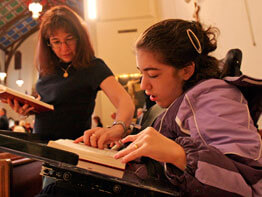WASHINGTON – One child might benefit from a tactile and descriptive tour of his religious education classroom. Another might be better able to learn with a strict routine, outlined on a picture schedule. A third might need a note-taker or captioned instructional films or videos.
Those strategies and many more were discussed during a recent “Webinar” on catechesis for children and youths with disabilities, hosted by the Washington-based National Catholic Partnership on Disability and several other Catholic organizations.
At least 500 participants at 325 sites around the country joined in the May 6 Web-based seminar, which focused on ways to bring children with autism spectrum disorders, developmental disabilities or visual or hearing impairments into full participation in religious education classes at the parish or diocesan level.
Sister Kathleen Schipani, a Sister of the Immaculate Heart of Mary who is administrator of the Department for Pastoral Care for Persons With Disabilities in the Archdiocese of Philadelphia, said catechists should follow the example of Jesus, who asked the blind man Bartimaeus: “What do you want me to do for you?”
Anne Masters, director of pastoral ministry with people with disabilities in the Archdiocese of Newark, N.J., agreed that the key is to “begin by welcoming the child before you” and to find out what he or she needs.
“Child by child we have learned how to respond to the needs” of children and teens with autism, she said, adding that parents and teachers can be “great sources of insight and guidance.”
Masters recommended that those teaching children or teens with autism use short phrases and reinforce their words with visuals; avoid speaking in the negative and wait before repeating themselves; and provide “advance warning systems” such as a verbal countdown or a picture schedule to help their students transition from one activity to another.
Children with intellectual or physical developmental disabilities might benefit from having a “religious education buddy,” Masters said. “The goal is always connection to the larger community,” she added.
Masters said an estimated one in 166 children nationwide has autism spectrum disorders, with boys more likely to be affected than girls. The disorder particularly affects the child’s social skills, language expression and understanding and can be manifested by the child flapping his or her hands, rocking or carrying out other repetitive behaviors, she said.
But she cautioned against generalizations about those with autism, recalling a saying that goes, “If you know one person with autism, you know one person with autism.”
“You need the relationship,” Masters said. “You need someone who can recognize when something isn’t right.”
Sister Kathleen offered advice on how to improve the religious education experience for children or youths who are hard of hearing or visually impaired.
These youngsters “vary in their intellectual abilities” but all can benefit if the student, his or her parents and the catechist meet before classes begin “to discuss the setting and method of learning,” as well as other factors that can affect the learning environment, Sister Kathleen said.
Strategies to improve learning can be as simple as the use of black Sharpie markers on curriculum materials or the teacher making sure she does not cover her mouth or turn away from students who might be reading her lips, she said.
In a question-and-answer session, both women offered ideas for how to involve the whole parish in helping make religious education as inclusive as possible.
For example, a deaf or hard-of-hearing student could benefit from having course materials e-mailed to his or her home each week, Sister Kathleen said. “You might know a computer geek who might not want to be a weekly teacher but can scan and input those materials each week,” she said.
A retired person who is “a great typist” might be willing to prepare the teaching materials for use in a closed-captioning system, she added. Or someone with a good speaking voice could record the materials for use by the blind or visually impaired.
Other jobs require little in terms of specific skills. A resource distributed by Masters’ office in the Archdiocese of Newark says caring adults and teens can be “extra eyes, hands, legs and hearts” in the classroom.
“The talents are out there,” Masters said. “You just have to reach out to the wisdom and talents in your parish.”
Participants in the Webinar were able to download materials outlining tips and resources for a variety of teaching challenges. Those materials remain available on the Web site of the National Catholic Partnership on Disability at www.ncpd.org.
Other groups involved in the Webinar were the National Conference for Catechetical Leadership, National Catholic Educational Association, National Apostolate for Inclusion Ministry and National Catholic Office for the Deaf.


